Last updated: January 3, 2022
Article
John Glover: Sailor, Soldier, Patriot

John Glover: Sailor, Soldier, Patriot
Through expert seamanship, military leadership, and pure grit, John Glover helped to save the American independence movement from possible disaster in 1776.
Born in Salem, Massachusetts, November 7, 1732, John, his mother, and three brothers moved to Marblehead after the early death of his father. Inheriting nothing, John was an example of an American success story, quickly becoming one of the wealthiest and most influential members of the close–knit seaport establishment as a ship owner and international merchant. Long before the outbreak of hostilities with Great Britain, Glover had become active both militarily and politically, joining the town militia, and ultimately becoming commander. At the same time, as Britain took away more and more of the New England colonies’ political and commercial rights, Glover became an increasingly radical Whig, openly advocating independence. When war became imminent, Glover was able to raise a regiment of 500 men composed of his militia and Marblehead seamen, and termed by Washington as soldiers “bred to the sea.” Some of these were Spanish, Native Americans, Jewish, and even African-Americans – forming one of the first integrated units in the service.
After building up seacoast defenses, Glover was ordered to New York, where he and his “Marbleheaders” provided valuable assistance in the evacuation of Washington’s 9,000 men, horses, and artillery from Brooklyn to Manhattan on August 29, in one night against the tide, all without being seen or heard by the nearby British warships; he thereby helped save the cause of independence from collapse.
Then, after being given command of a skeleton brigade of 800 men, he and his soldiers stopped the panicked retreat of the Continentals at Kip’s Bay. Glover was then sent to Pell’s Point on Pelham Bay on October 14, to slow down, as much as possible, a probable amphibious invasion led by General William Howe that could cut off Washington’s retreat to White Plains. On the morning of October 18, Glover saw British ships unloading 4,000 Hessian and British soldiers heading ashore, while Glover had four small, but effective regiments of Massachusetts Continental troops in his brigade to try to harass the enemy landing.
Knowing that the enemy would be coming up Split Rock Road, Glover took advantage of the stone walls running along each side and crossing the fields, and deployed three of his regiments each behind an intersecting wall: Colonel Joseph Reed’s, left and front; Colonel William Shepherd’s, behind and across to the right; and Colonel Loammi Baldwin’s, behind Shepherd’s. Waiting as the Redcoats came within range, Reed’s men stood up from behind the wall and engaged the enemy, then moved back to reinforce the next. Twice more, each regiment deceived the oncoming enemy with the same maneuver, slowing down the Anglo-Hessian advance. Finally, in the face of a flanking movement led by General Cornwallis that could have cut off his forces, Glover ordered his brigade back down the hill, across Hutchinson Creek and up the hill to where he had left his own regiment and cannons. For the rest of the day, the two sides exchanged cannon fire; instead of advancing as planned, the Anglo-Hessian forces remained in the vicinity for the next three days, using Saint Paul’s Church as a hospital.
By holding off the enemy’s movement, Glover effectively covered Washington’s retreat to reach White Plains. There, Glover rejoined the Army and was active in the Battle of White Plains. Remaining there with General Charles Lee until late December, Glover and his brigade crossed the Hudson, and reunited with Washington in New Jersey. There, in Trenton, on the night of December 25, 1776, Glover and his “Marbleheaders” ferried 2,400 troops – again with horses, artillery, and wagons – across the Delaware River under extreme winter weather conditions. They participated in the Battle of Trenton, and transported the army, as well as nearly 1000 Hessian prisoners, back across the river, all on the same day.
For these stellar military exploits of 1776, John Glover was promoted to brigadier general in February of 1777, and joined General Horatio Gates at Saratoga, commanding a brigade. But sometime during the course of the campaign, Glover contracted what was probably malaria. His health did not improve, but, because of patriotism and dedication, he remained in the service: transporting the Convention Army, serving at various defensive posts in the Hudson Highlands, and acting as judge and officer of the day at Major John Andre’s trial and execution.
Brigadier General Glover retired from the army on July 22, 1782. He was later elected as a Federalist delegate to the Massachusetts ratifying convention for the Constitution; he served as town selectman, and in the Massachusetts House of Representatives. John Glover died from a liver infection in 1794, at age 62, perhaps caused by the illness that had weakened him for so long. He is commemorated in Marblehead, in Brooklyn, and in the area around Saint Paul’s National Historic Site.
